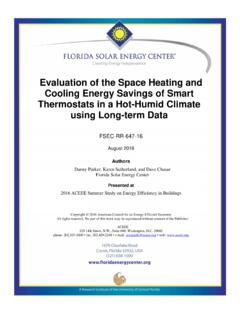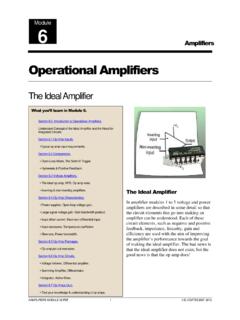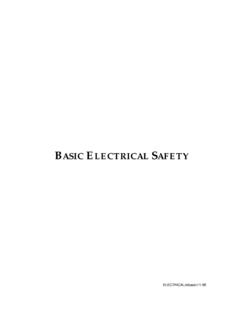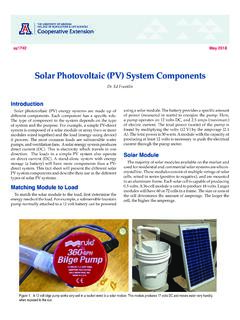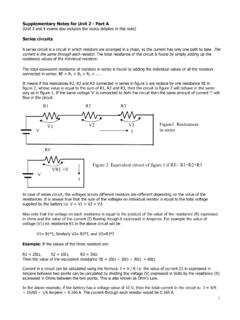Transcription of Photovoltaic Power Output & I-V Curves
1 Understanding Solar Energy Teacher Page Photovoltaic Power Output & I-V Curves Student Objective Key Words: The student: active area efficiency will be able to determine the voltage, ampere (amp). current and Power of a given PV circuit module current given the efficiency, irradiance and direct current (DC). the Power (watt) rating of a module, efficiency will be able to determine the size of insolation meter the array necessary to produce given I-V curve amounts of Power load given an I-V curve, will be able to maximum Power current (Imp). determine the module's maximum maximum Power point (Pmp). Power point maximum Power voltage (Vmp). will be able to explain how an I-V module curve is generated.
2 Multipurpose meter ohms Materials: Ohm's Law laboratory manual open circuit voltage (Voc). key word list Power (DC). Photovoltaic module, any size (3V, short circuit current (Isc)..3A panel is used in examples) solar irradiance insolation meter (solar meter) solar noon multimeter (2 per group) total area efficiency technical specifications for module variable resistor (rheostat). being used including voltage, voltage amperage, open circuit voltage, short circuit amperage and maximum Power rating Time: variable resistor (rheostat), with 1- 2 class periods current rating greater than short circuit current for module wires with alligator clips (4 per group). thermometer tape graph paper ruler Florida Solar Energy Center Photovoltaic Power Output & IV Curves / Page 1.
3 Procedure (prior to class). 1. Look up your local latitude if you are unfamiliar with it. 2. Familiarize yourself with the multimeter that the students will be using. When measuring amperage a load must be used unless you are using a fused multimeter. 3. Make sure that the Power rating of the variable resistor (rheostat) exceeds the maximum Power rating of the module and that the resistance (ohms) falls withing 20% of the maximum Power point resistance (R = V/I). For the 3V panel use a 3 watt, 100 ohm rheostat. 4. If term review is needed (open circuit voltage, short circuit current , maximum Power voltage, etc), assign the Key Word Crossword to be completed either in paper or online version.
4 Procedure (during class time). 1. Engage: Lead a discussion on what the students may already know about solar energy in general and photovoltaics in particular. Points to cover should include: the distinction between solar thermal (using solar energy to heat something) and photovoltaics (turning solar energy directly into electricity). current uses of photovoltaics that the students might be familiar with ( highway call boxes, road signs and billboards, signal buoys, satellites, as well as calculators, watches and radios). 2. If this is the first time the class has worked with electricity, lead a discussion of what they already know about basic electrical circuits. Points to cover should include: the circular nature of a circuit direct current (DC) is a flow' of electric charge from the positive to the negative charge.
5 This type of current is found in batteries, Photovoltaic devices and thermocouples Alternating current (AC) is the type of electrical charge carried through utility lines. This type of current reversed by fluctuating magnetic fields amperage (amp) is the unit of measure of the rate of flow voltage (volt) is the unit of measure of the force of the push' through the circuit . 3. Students should work in teams of 3 - 5 students. Pass out materials. If you are using the 3V PV panels, remind students that the panels are fragile and may be broken if bent 4. If this is the first time the class has used a multimeter, explain its basic function and use. 5. Students should complete the activities in the Laboratory Manual.
6 Related Reading Photovoltaics: Design and Installation Manual by Solar Energy International (New Society Publishers, 2004). Solar Energy International (SEI) is a non-profit that trains adults and youth in renewable energy and environmental building technologies. This manual is well-suited for those who have some electrical experience, and students in high school tech prep-level courses. The book contains an overview of Photovoltaic electricity and a detailed description of PV system components, including PV modules, batteries, controllers and inverters. It also includes chapters on sizing photovoltiac systems, analyzing sites and installing PV. Florida Solar Energy Center Photovoltaic Power Output & IV Curves / Page 2.
7 Systems. Internet Sites Florida Solar Energy Center's Photovoltaic fundamentals page explains the basics of Photovoltaic cells including their manufacture, the components of systems, as well as the pros and cons of Photovoltaic Power . Common electrical formulas and conversions with math tutorial links New Mexico Solar Energy Association's From Oil Wells to Solar Cells: A Renewable Energy Primer. Contains an overview of renewable energy including benefits, costs and obstacles to implementation. Also includes a good introduction to solar energy technology. New Mexico Solar Energy Association. A basic explanation of how a Photovoltaic cell produces electricity. Florida Solar Energy Center Photovoltaic Power Output & IV Curves / Page 3.
8 Understanding Solar Energy Answer Key Photovoltaic Power Output & I-V Curves Laboratory Exercises 1. Answers will vary, but should be fairly consistent between groups. 2. Answers will vary, but students should show a knowledge of how to apply an equation to calculate the Power values. 3. Student's readings will probably be lower than published module specifications. This is mainly due to environmental factors and not using the optimum tilt angle. 4. Answers will vary, but students should show evidence that they are considering real world conditions (such as weather) to be mitigating factors. 5. Data readings will vary, but should show some consistency between groups.
9 There still will probably be a variance between groups however, since the students haven't yet learned about tilt angles, and may not be using the optimum angle. 6. Answers will vary, but student's I-V Curves should follow the typical shape, and be labeled and titled correctly. The x- axis is voltage, y-axis is current , and graph intervals should be even. The title of the graph should include the irradiance level and temperature. 7. Answers will vary but should come from the appropriate points on the graph. Students should be able to find the maximum Power point from their graphs. 8. Student's readings will probably be lower than published module specifications. 9. Answers will vary, but students should show evidence that they are considering real world conditions (such as weather) to be mitigating factors.
10 10. Students should mention weather and the intensity of sunlight. They may also realize that tilt angle can cause discrepancies in the data. More data points could also increase the reliability of the data. 11. Answers will vary, but students should show proper use of the formula for efficiency. 12. Students readings will probably be lower than published module efficiency. 13. Students should realize that an increase in values for either the irradience level or the Power Output in the equation will mean a higher efficiency value. 14. With an efficiency rating, insolation data for a given area and a desired Power Output , the size of the array necessary for that load can be determined.


